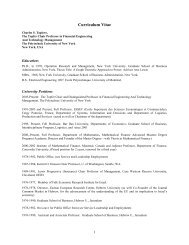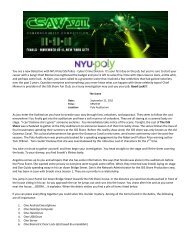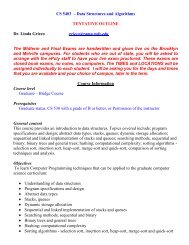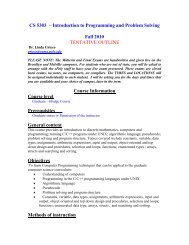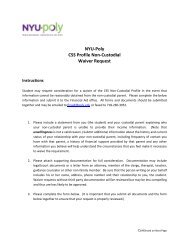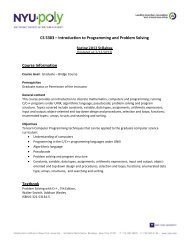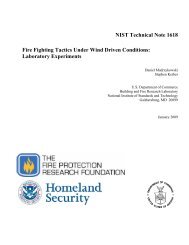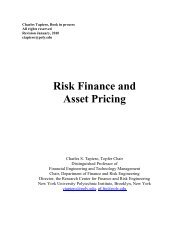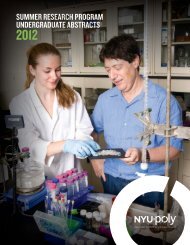A New University New Age - Polytechnic University
A New University New Age - Polytechnic University
A New University New Age - Polytechnic University
Create successful ePaper yourself
Turn your PDF publications into a flip-book with our unique Google optimized e-Paper software.
5 ✯ Jerry MacArthur Hultin, <strong>Polytechnic</strong> <strong>University</strong><br />
Adams, coined the expression, ‘the American Dream.’<br />
Third, the new university must be a global<br />
gateway to urban centers, both here and abroad,<br />
not an enclave, but a hub of collaboration and<br />
alliances with links around the world.<br />
To teach in this new age, we can use the urban<br />
landscape that surrounds us. Where better than the<br />
hurly-burly, rough and tumble boroughs of <strong>New</strong><br />
York to comprehend and design urban security,<br />
communications, transportation and quality of life.<br />
Internships with companies, governments and nonprofits<br />
will expand our students’ skills and enhance<br />
our communities. As Bob Kerrey, president of the<br />
<strong>New</strong> School, notes: one of the best places to hold a<br />
fruitful dialogue about the problems of Kashmir is<br />
not India or Pakistan, but rather Brooklyn or Queens.<br />
Think of a today’s young science or engineering<br />
student, fluent in English and also totally at ease<br />
in his or her family’s Chinese, Russian, Spanish or<br />
Farsi. Throughout life, he or she will have a special<br />
advantage whether doing research, starting a new<br />
business, or building a new city.<br />
For him or her, the American Dream will be<br />
the “Urban Dream” and the “Global Dream.”<br />
Fourth, as the new university grows, it will<br />
need to rethink vestiges of the current model. For<br />
instance,<br />
• How will we curb the price of tuition at this new<br />
university?<br />
• How will we give undergraduates an exciting<br />
role in research?<br />
• How will we re-engineer research so that the<br />
artificially linear funding categories — basic,<br />
applied, development — are fused into a more<br />
holistic, creative and entrepreneurial approach?<br />
A university can transform<br />
itself if…it is small enough to<br />
be agile and smart enough to<br />
think innovatively…<br />
Inaugural Address ✯ September 29, 2005 ✯ 6<br />
The Brooklyn Bridge<br />
• How will we integrate management, the humanities<br />
and social sciences more fully into our<br />
technical education?<br />
• How will we bring new faces to the governing<br />
boards of the new university? For the new university<br />
I have in mind will need a fresh contingent of<br />
trustees who know the entrepreneurial character<br />
of large urban centers around the world.<br />
✶ ✶ ✶ ✶ ✶<br />
How do we create such a university?<br />
One could, of course, repeat history in the manner<br />
of Johns Hopkins in 1876 and create it from whole<br />
cloth. Indeed, the recently opened Olin College of<br />
Engineering near Boston hopes to do just this.<br />
But one can also transform an existing university<br />
to meet these challenges. Such a transformation is<br />
unlikely at the most eminent of our great universities.<br />
They are, in the words of Clay Christensen, caught<br />
in the innovators dilemma with ‘rules’ that prevent<br />
them from seeing and responding to the perils of<br />
obsolescence.<br />
However, a university can transform itself if<br />
it has less at stake and more to gain; if it is small<br />
enough to be agile and smart enough to think<br />
innovatively; if it has diversity within its faculty<br />
and students; and if it has friends and supporters<br />
who will provide resources.<br />
✶ ✶ ✶ ✶ ✶




